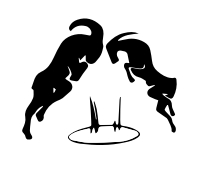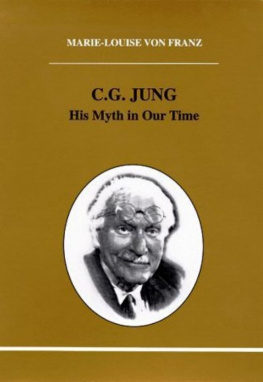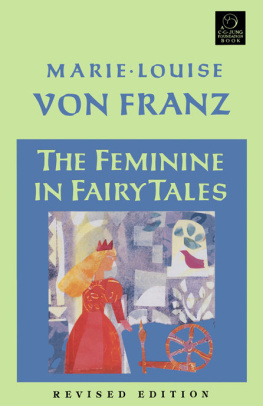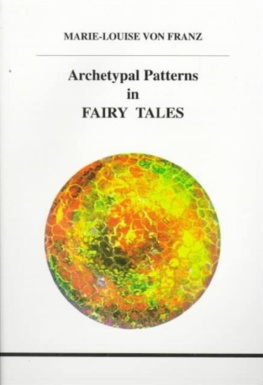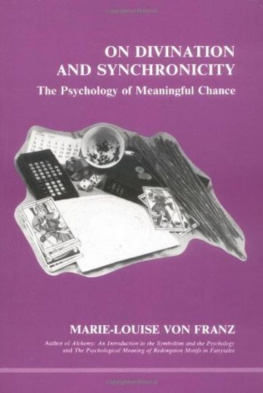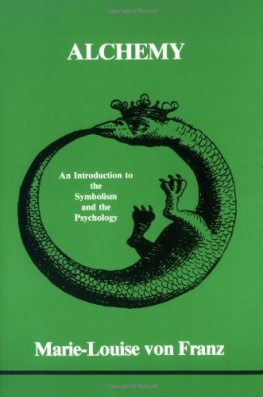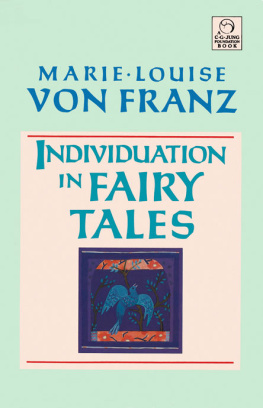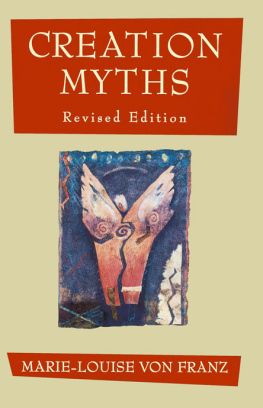Table of contents
Guide
Part One: The Inferior Function by Marie-Louise von Franz
Copyright 2015 Spring Publications, Inc.
Part Two: The Feeling Function by James Hillman
Copyright 2015 Margot McLean
All rights reserved
ISBN 978-0-88214-002-5 (e-book edition, v. 2.1)
Published by Spring Publications
www.springpublications.com
Cover image from Essays on Physiognomy Designed to Promote the Knowledge and Love of Mankind by Johann Caspar Lavater (London 1810).
MARIE-LOUISE VON FRANZ
JAMES HILLMAN
Lectures on
Jungs Typology
SPRING PUBLICATIONS
THOMPSON, CONN.
Part One
MARIE-LOUISE VON FRANZ
The Inferior Function
A General Characterization of the Inferior Function
Psychological Types is one of Jungs earliest books. When he wrote it, he was in many respects struggling in the dark. Since the book was written, the idea of the four functions of consciousness, and the functioning of the conscious human personality in this fourfold way, has proved tremendously productive. The idea of the four functions evolved in Jungs thought and even turned up in the religious problem of the three and the four.
For those who are unfamiliar with this field, I must give a brief sketch of the pattern of the four functions in Jungian psychology. Jung first differentiated two attitudinal types: the extrovert and the introvert. In the extrovert, the conscious libido habitually flows towards the object, but there is an unconscious secret counteraction back towards the subject. In the case of the introvert, the opposite occurs: he feels as if an overwhelming object wants constantly to affect him, from which he has continually to retire; everything is falling upon him, he is constantly overwhelmed by impressions, but he is unaware that he is secretly borrowing psychic energy from and lending it to the object through his unconscious extroversion.

This diagram represents the difference between the extrovert and the introvert. The four functionssensation, thinking, feeling and intuitioneach of which can be extroverted or introverted, produce eight types: extroverted thinking, introverted thinking; extroverted feeling, introverted feeling, etc.
I am assuming you know about the arrangement of the functionsnamely, that the two rational functions, thinking and feeling, are opposite each other, as are the two irrational functions, sensation and intuition:
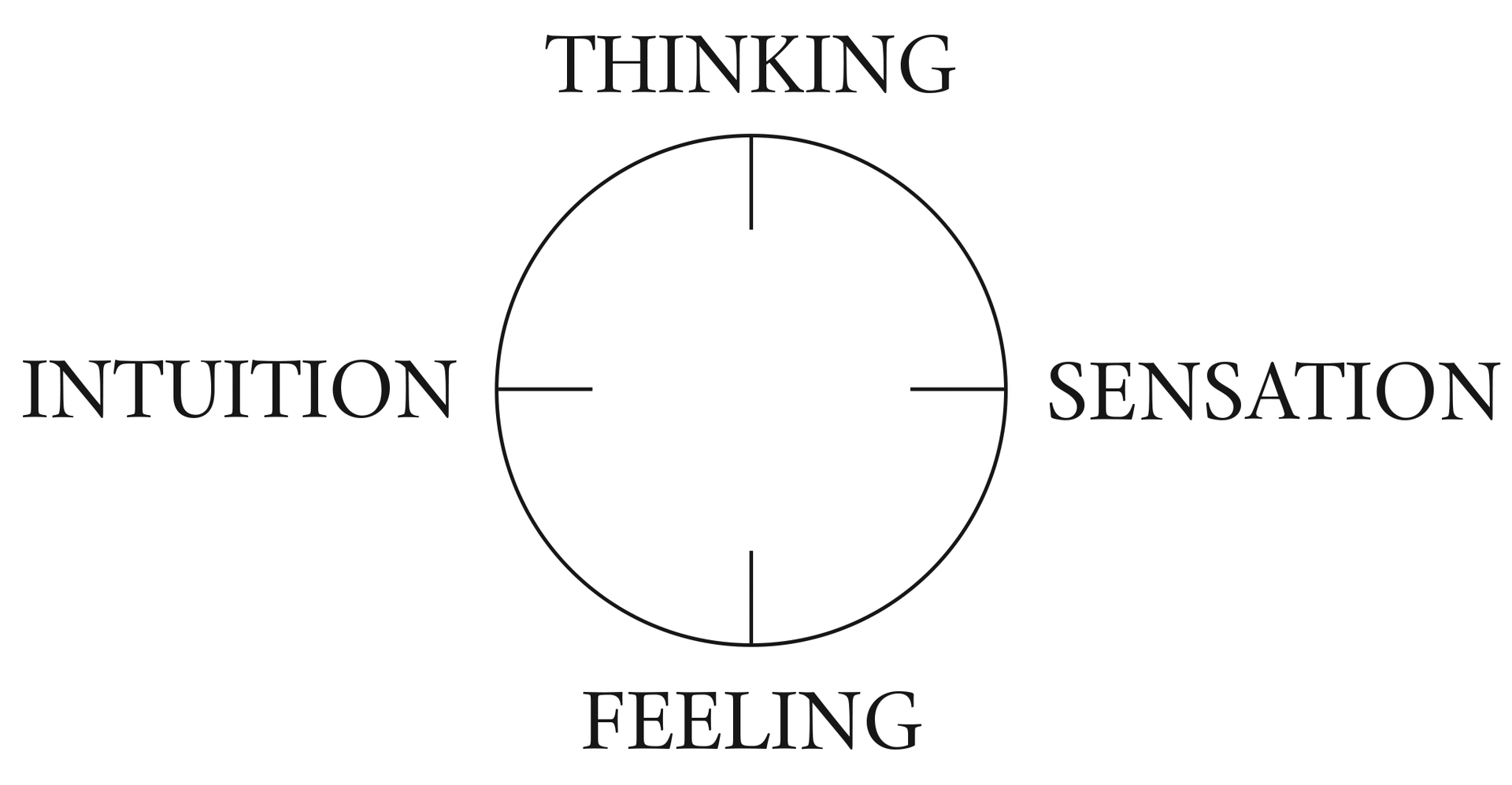
The question has often been raised: why on earth should there be four functions? Why not three? Or five? That cannot be answered theoretically; it is simply a question of checking facts and of seeing whether one can find more or fewer functions and another typology. For Jung it was a great discovery when he later found confirmation of his more intuitively conceived idea in the fact that everywhere in myths and religious symbolism there appears the model of the fourfold structure of the psyche. In studying the behavior of his patients, he found that he had apparently hit upon a basic structure. Naturally, the basic fourfold structure of the psyche, which means more than only the conscious functions, is generally represented as a purely primitive self-manifestation of the unconscious, usually as an undifferentiated quaternion. There are just four principles of more or less the same kind: four colors, or angles, or gods, etc. The more they are connected with consciousness, the more they tend to become three animals and one human being, or three good gods and one evil god. One also finds those more differentiated mandalas where the four poles of the quaternary structure are different from each other, particularly if the material has been consciously worked upon a great deal. There one often finds the classic problem of the three and the four about which Jung has written so much. This means that when, from this basic structure, one or the other functions becomes conscious, or where under optimum conditions three functions become conscious, this has the effect of also changing the basic structure of the psyche. Neither in psychology nor in any other field of reality is there ever a one-sided course of action, for if the unconscious builds up a field of consciousness, the repercussion of such a change produces an alteration in the unconscious structure as well. Therefore when one finds in dreams and mythological material that this basic structure appears in an altered form, it can be concluded that a part of the problem of the functions has already become conscious, and, due to the counteraction, even the basic structure of the psyche has a changed or modified form.
The differentiation of types starts in very early childhood. For instance, the two attitudesextrovert and introvertcan actually be seen in a child of one or one-and-a-half, though perhaps not always very clearly. Jung once told of the case of a child who would not enter a room before it had been told the names of the pieces of furniture theretable, chair, etc. That is typical of a definitely introverted attitude, where the object is terrifying and has to be banished or put in its place by a word, a propitiating gesture by which the object is made known and cannot misbehave. In such little details, if you know how to look for them, you can observe the tendency towards introversion or extroversion in a very small child.
The functions, naturally, do not show so early, but by the kindergarten age one can usually observe the development of a main function by a preference for some occupation or by the childs behavior towards another child. Children, like adults, tend to do frequently what they can do well and to avoid the things they cannot do well. Probably most people do as I did with my school work: I was gifted in mathematics and did that first, leaving whatever I was not good at till the end. The natural tendency is to defer doing, or to push off on other people, the thing in which one does not feel superior. By such natural behavior, the one-sidedness is increased more and more. Then comes the family attitude: the boy who is very intelligent must study later on, or the child gifted in practical matters must become an engineer. The surroundings reinforce the existing one-sided tendencies, the so-called gifts, and there is thus an increase in the development of the superior function and a slow degeneration of the other side of the personality. This is an unavoidable process and even has great advantages. Many people fit into this pattern, and one can tell their type at once; others may be very difficult to define.
Some people have trouble in finding out their own type, which very often is due to the fact that they are distorted types. This is not a very frequent occurrence, but it does happen in cases where someone would naturally have become a feeling type or an intuitive, but was forced by the surrounding atmosphere to develop another function. Suppose a boy is born a feeling type in an intellectually ambitious family. His surroundings will exert pressure upon him to become an intellectual, and his original predisposition as a feeling type will be thwarted or despised. Usually, in such a case, he is unable to become a thinking type: that would be one step too far. But he might well develop sensation or intuition, one of the auxiliary functions, so as to be relatively better adapted to his surroundings; his main function is simply out in the milieu in which he grows up.

